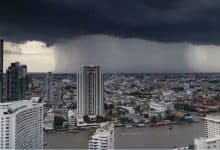Thailand on high alert for intense geomagnetic storm

Thailand is currently bracing for a severe geomagnetic storm, the likes of which haven’t been recorded in recent history. The storm, reaching a level 7 intensity, is expected to present two significant effects: mesmerising auroras for high-latitude regions and potential disruptions to satellite communications.
This forecast emerged following recent solar flare activities, which have been closely monitored by the Geo-Informatics and Space Technology Development Agency (GISTDA). Since the evening of May 10, approximately at 4pm Thai time, officials have been on high alert.
The planet is in the grip of one of the most severe geomagnetic storms ever recorded, akin to the historic Carrington event of 1859 and the more recent Halloween solar storm of 2003. Originating from a massive sunspot region AR 3664, the current solar activity has unleashed several coronal mass ejections (CMEs) into space, causing continuous solar winds to affect Earth.
According to the latest updates from the National Oceanic and Atmospheric Administration (NOAA), the solar wind velocity has reached an astonishing 835 kilometres per second, with a peak magnetic field (Bt) of 74 nanoteslas and a Bz component of -45 nanoteslas, indicating a direct impact on Earth.
On the evening of May 10, and into the afternoon of May 11, the Kp index, a measure of geomagnetic activity, hit the top of the scale at Kp index = 9, or level G5.
Sittiporn Kanjanasindhu, Director of the Space Technology Research Centre at GISTDA, shared that the local k index for Thailand indicated a level 7 or G3 strength last night, pointing to a strong level of geomagnetic activity.
Electrical systems
This could result in two primary impacts: an increased chance of witnessing the Northern Lights in high-latitude countries and potential disruptions to satellite operations, including navigation and communication satellites. Additionally, high-frequency radio signals in the HF/VHF/UHF networks and electrical systems might be temporarily affected.
GISTDA, equipped with the space weather forecast system JASPER, collaborates internationally to monitor these events. The data utilised comes from magnetometers, a joint project between GISTDA, Japan’s National Institute of Information and Communications Technology (NICT), and Prince of Songkla University, located near the geomagnetic equator in Southern Thailand’s Science Park.
GISTDA and its partners are committed to continuous monitoring and will provide updates as the situation evolves, reported Bangkok Post.
Residents and authorities alike are urged to stay informed and prepared as the geomagnetic storm unfolds, with the potential for breathtaking auroras and the need for contingency plans in the face of satellite and communication challenges.
Latest Thailand News
Follow The Thaiger on Google News:


























